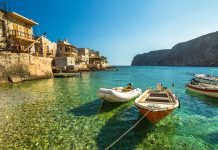It is impossible not to fall in love with Hasankeyf. A bright honey-colored village clung to the rocks of the gorge above the Tigris River, it represents Cappadocia in miniature, and it just needs to be examined before this miracle disappears under the water. While working on the book, this project was designed for 2015, a new city – Yeni Hasankeyf – has already begun to be built on the other side, on a higher site.
Meanwhile, don’t miss Hasankeyf, which has become a popular tourist destination, especially among Turkish tourists.
Attractions
On the main road to Batman there is the restored mausoleum of Zeynel Bey turbesa, cut off by a field by the river. The conical tomb, decorated with turquoise tiles, was built in the middle of the XV century. For Zeynel, the son of the governor of Akkuyunlu, it is one of the few surviving monuments of that period.
Today, the banks of the Tigris are connected by a modern bridge, but on the right are the destroyed arches and pylons of the Old Bridge – Eski Kepru. Their size indicates the importance of Hasankeyf in the times immediately preceding the appearance of the Ottomans.
HIDDEN TREASURES ON THE TYUR-ABDIN PLATEAU
If you are driving or have hired a taxi for a day trip to Midyat, you will be able to explore the Tyur-Abdin plateau, the historical homeland of the Syrian Orthodox Church, without any problems. The plateau is dotted with historic village churches and monasteries, some of which have recently been restored. Here are the places you can’t miss:
- Mor Yakup, near Baryshtepe ;
- MorIzo Hall, towering on a hill in Altyntas ;
- Mor Kyriakos in Baglarbashi ;
- Mor Dimet in Izbarak ;
- Meriemana in Anytli
- Mor Eliyo in Alagez.
Hasankeyf is threatened by the implementation of a large engineering project. Despite its beauty and rich history, the city is condemned to flooding as a result of the planned construction of the Ilisu dam in 2012 as part of the project for Southeastern Anatolia, an irrigation and hydropower project that is due to come into operation in 2015. The planned dam will flood the area from Batman to Midyat, hiding this historical site and several other archaeological treasures under water, while more than 37 villages should be relocated.
The castle and caves are visible behind the bridge. El Rizk Jami Mosque. The El-Rizk Mosque has a beautiful, slender minaret similar to the minarets in Mardin, which crowns the stork’s nest. Right behind the mosque, the path splits: from the right down to the river. On the left, the road leads through the rock defile to the ticket office of the fortress. This strategic place attracted the Byzantines, but most of the relics that appear today were built in the XIV century, during the reign of the Ayyubid dynasty. Behind the gate there are caves that young guides call shops and houses. At the top of the cliff are the ruins of a building built in the XIV century . Kuchuk is a shed with pitchers built into the walls and ceiling to improve sound insulation.
Nearby there is a small mosque, once a Byzantine church, and a Buyuk Shed, under which there is a terrible prison. Nearby is a former watchtower balancing on the edge of a cliff. The Ulu Jami Mosque was built on the site of the church in the XIV century.










